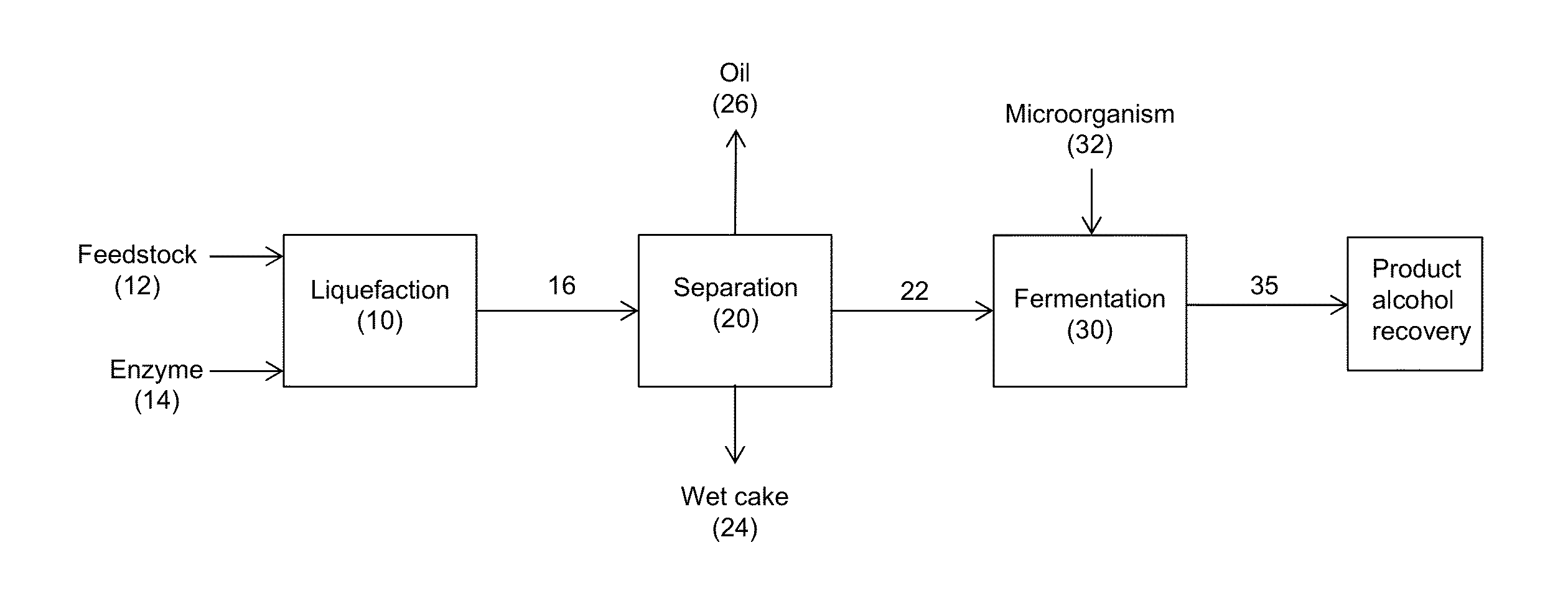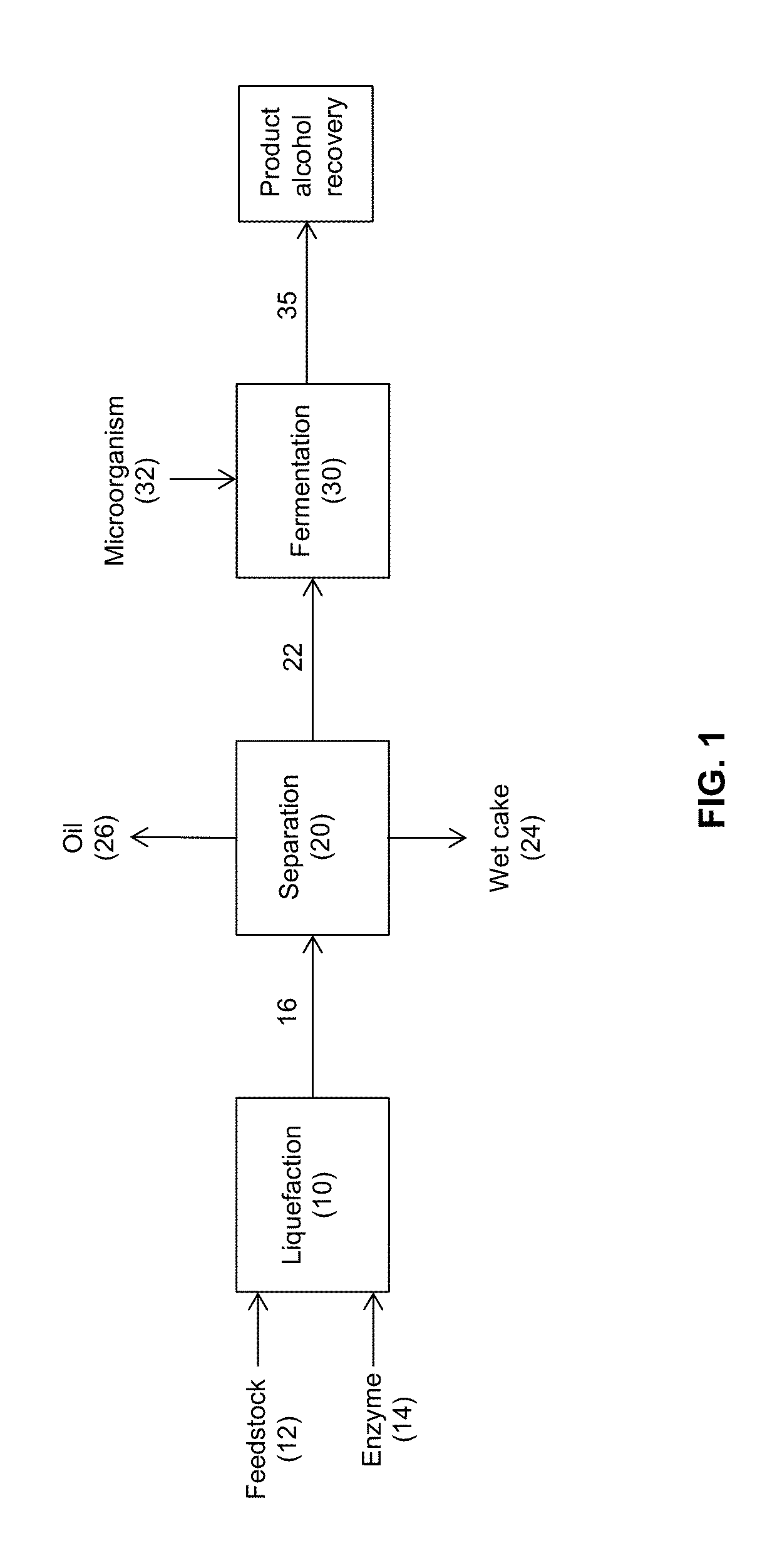Processes and systems for the production of alcohols
a technology of process and system, applied in the field of process and system for the production of alcohol, can solve the problems of reducing the mass transfer coefficient of a recovery method such as liquid, affecting the recovery of fermentative products, and reducing extraction efficiency, so as to improve the fermentation co-product profile and increase biomass processing productivity
- Summary
- Abstract
- Description
- Claims
- Application Information
AI Technical Summary
Benefits of technology
Problems solved by technology
Method used
Image
Examples
example 1
Separation of Corn Oil and Undissolved Solids from Corn Mash
[0096]Approximately 1000 g of liquefied corn mash was prepared in a 1 L glass, jacketed resin kettle. The kettle was set up with mechanical agitation, temperature control, and pH control. The following protocol was used: mixed ground corn with tap water (26 wt % corn on a dry basis), heated the slurry to 55° C. while agitating, adjusted pH to 5.8 with either NaOH or H2SO4, added alpha-amylase (0.02 wt % on a dry corn basis), continued heating to 85° C., adjusted pH to 5.8, held at 85° C. for 2 hr while maintaining pH at 5.8, cool to 25° C. The corn was ground in a hammer-mill using a 1 mm screen. The moisture content of the ground corn was about 11.7 wt %, and the starch content of the ground corn was about 71.4 wt % on a dry corn basis. The alpha-amylase enzyme was Liquozyme® SC DS (Novozymes, Franklinton, N.C.). The total amounts of the ingredients used were: 294.5 g ground corn (11.7% moisture), 705.5 g tap water, and 0....
example 2
Removal of Corn Oil from Liquefied Corn Mash
[0105]This example describes the use of a three-phase centrifuge to remove corn oil from liquefied corn mash. Liquefied corn mash was generated using a standard continuous liquefaction process as used, for example, in a dry-grind corn-to-ethanol process. The ground corn contained 4.16 wt % corn oil (dry corn basis) and had a moisture content of 14.7 wt %. Ground corn and water were fed to a slurry tank at 10.2 lbm / min and 17.0 lbm / min, respectively, to give a dry corn loading of 32 wt %. Alpha-amylase was fed to the slurry tank at a rate that corresponded to an enzyme loading of about 0.025 wt % on a dry corn basis. The slurry and liquefaction tanks were both run at 85° C. and pH of 5.8. The total residence time at 85° C. was about 2 hr. Mash was produced at a rate of about 3 gpm and contained about 1.3 wt % corn oil on a wet basis. A portion of this oil existed as free oil and a portion was in the undissolved solids. This corresponds to a...
example 3
Removal of Corn Oil from Liquefied Corn Mash—Feed Rate Adjustment
[0114]In this example, liquefied corn mash was fed to a three-phase centrifuge at a feed rate of 1 gpm. Liquefied corn mash was generated using a standard continuous liquefaction process as used, for example, in a dry-grind corn-to-ethanol process. The ground corn contained 4.16 wt % corn oil (dry corn basis) and had a moisture content of 14.7 wt %. Ground corn and water were fed to a slurry tank at 8.2 lbm / min and 19.0 lbm / min, respectively, to give a dry corn loading of approximately 26 wt %. Alpha-amylase was fed to the slurry tank at a rate of 50 g / hr, which corresponded to an enzyme loading of about 0.026 wt % on a dry corn basis. The slurry and liquefaction tanks were both run at 85° C. and pH of 5.8. The total residence time at 85° C. was about 2 hr. Mash was produced at a rate of about 3 gpm and stored in a 1500 gal tank. The mash contained about 1.1 wt % corn oil on a wet basis. A portion of this oil existed a...
PUM
| Property | Measurement | Unit |
|---|---|---|
| vol % | aaaaa | aaaaa |
| vol % | aaaaa | aaaaa |
| vol % | aaaaa | aaaaa |
Abstract
Description
Claims
Application Information
 Login to View More
Login to View More - R&D
- Intellectual Property
- Life Sciences
- Materials
- Tech Scout
- Unparalleled Data Quality
- Higher Quality Content
- 60% Fewer Hallucinations
Browse by: Latest US Patents, China's latest patents, Technical Efficacy Thesaurus, Application Domain, Technology Topic, Popular Technical Reports.
© 2025 PatSnap. All rights reserved.Legal|Privacy policy|Modern Slavery Act Transparency Statement|Sitemap|About US| Contact US: help@patsnap.com



